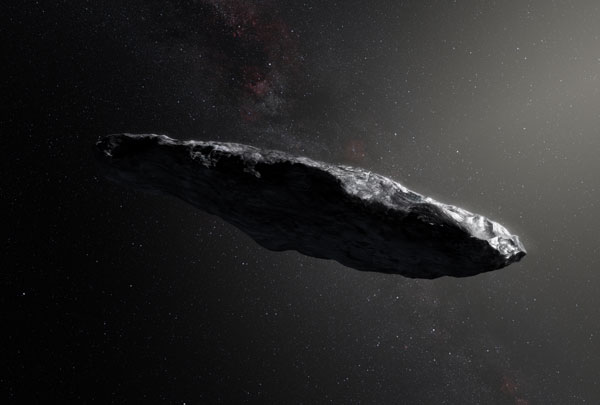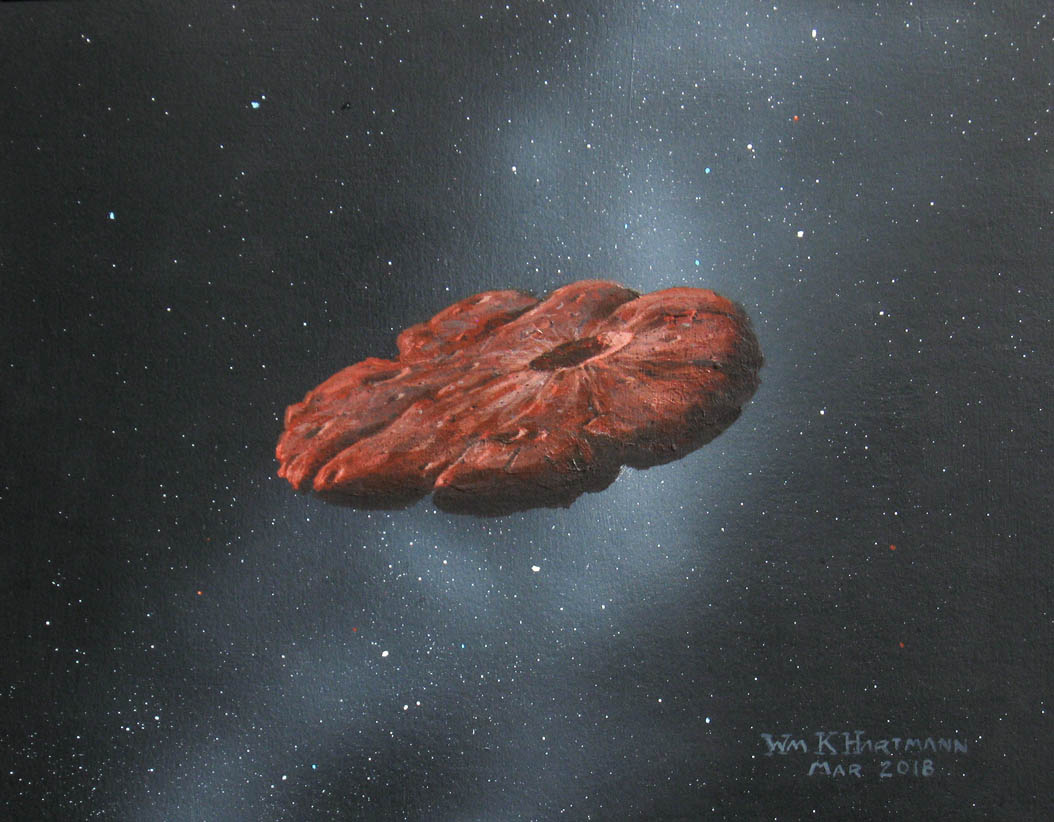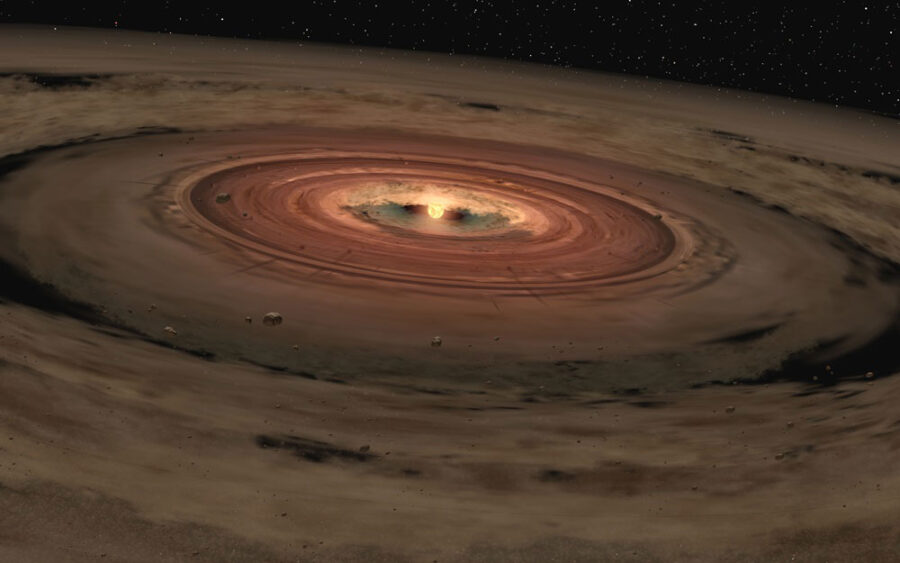The interstellar pancake named ‘Oumuamua might have been a chip off a Pluto-like object in another star system.
Humans have observed two interstellar objects to date, and have struggled to understand their origins and nature. At the Exoplanets in Our Backyard 2 workshop held in Albuquerque, New Mexico, Steve Desch (Arizona State University) presented a plausible scenario that accounts for all aspects of the first known interstellar object, 1I/`Oumuamua.

ESO / K. Meech et al.
To recap, `Oumuamua was first spotted by the Pan-STARRS telescope in Hawai`i on October 19, 2017, already past perihelion and on its way back out of the solar system. Its strong brightness variations hinted at a non-spherical shape. It also slowed more than expected — 10 times more than it would if it were a typical comet — as it exited the solar system, a phenomenon called non-gravitational acceleration. There was also no visible coma, nor a tail of either dust or gas.
`Oumuamua is long beyond the reach of telescopes now, but studies continue. In 2019, Sergey Mashchenko performed a careful analysis of its light curve and found that the best-fit shape for Oumuamua is not a cigar, as it’s often depicted, but a pancake about 6 times wider than it is thick (it measures 113 by 111 by 19 meters).

ESO / M. Kornmesser

© William K. Hartmann
Such an extremely flattened shape is almost unheard of in the solar system. What could account for `Oumuamua’s strange shape, extra-cometary acceleration, lack of visible cometary activity, and extrasolar origin?
All observed comets have very low albedo, reflecting only a few percent of the light that strikes them. But what if, Desch and team member Alan Jackson (also Arizona State) surmised, `Oumuamua was made of something brighter, some kind of ice?
Desch and Jackson investigated the sublimation behavior of various ices common in the outer solar system, such as carbon dioxide, ammonia, oxygen, nitrogen, carbon monoxide, neon, and methane. They found that if `Oumuamua were made of nitrogen ice, it would have the right albedo and the right mass to produce the exact amount of non-gravitational acceleration observed by astronomers as it retreated from the Sun. And if it were nearly pure nitrogen ice, it would exhibit this cometary behavior without any of the hallmarks of comets, neither reflecting sunlight from dust nor lighting up with emission from water or other gases.
Hypothesizing pure nitrogen ice for Oumuamua’s composition solves some other puzzles, too. The body passed within 0.2 astronomical units (a.u.) of the Sun (20% of the distance from the Sun to Earth), and yet it survived to exit the solar system. But only barely, according to Desch and Jackson’s model. A nitrogen-ice `Oumuamua would have lost 95% of its mass by the time it exited the inner solar system; evaporative cooling would have insulated the remaining morsel through the harrowing passage.
That much mass loss also explains the extreme shape. If you add 20 times the present mass in concentric layers around the present pancake, reversing its evaporation by the Sun, the original body would have had a much more normal 2:1 aspect ratio.
Where would such a big chunk of nitrogen ice have come from? Within our solar system, there are a few worlds in the Kuiper belt, such as Pluto and 225088 Gonggong, that might have lost chunks of dust-free, nearly pure nitrogen ice crust to impacts. In a 2021 paper, Desch and Jackson worked out that during the formation of the solar system, about 100 trillion ice fragments would’ve been ejected from our solar system, two-thirds of them nitrogen ice. For perspective, that’s more ice fragments ejected from our solar system than there are comets in the Oort Cloud!
But even though 100 trillion is a big number, statistically speaking it just isn’t enough to make enough pieces that one of them is likely ever to have come through our solar system when we were capable of looking.

NASA / JPL-Caltech
Here is where we get to the new (and, as yet, unpublished) work. Our Sun isn’t the most common type of star; cooler M-type stars are much more common. M stars are more favorable environments for the creation of worlds covered in nitrogen ice. In our solar system, you have to be nearly at the orbit of Neptune, at 15 a.u., for nitrogen ice to be stable on the surface. However, stars at the lower end of the mass range (technically classified as M8) can host worlds with nitrogen ice at only 1 a.u.
Taking into account the huge population of M stars and their more favorable environments for hosting nitrogen ice, Desch and Jackson found that M stars will have ejected 40 times more nitrogen ice fragments than stars like our Sun.
That contrast is enough for `Oumuamua’s appearance in our backyard to be a likely accident. Its trajectory, which lies in the galactic plane and has relatively low speed for an interstellar interloper, indicates that it hasn’t been roaming the galaxy on its own for very long; it probably exited its parent solar system up to a few hundred million years ago.
Desch and Jackson point out that if the object were about 500 million years old, it would likely have come from a young star in the Perseus arm of the Milky Way. If so, our observations of `Oumuamua were of a fragment of the surface of a young exoplanet — and we’re likely to be visited by more such interplanetary travelers in the future.
 7
7









Comments
Science
November 17, 2022 at 11:15 am
This is a great article. I found it fascinating. Would it be possible for me to reprint it in our club newsletter and share with members?
You must be logged in to post a comment.
Lindsay
November 18, 2022 at 6:32 pm
From `Oumuamua’s trajectory and speed, would it be possible to estimate the density of such a pancake and rule-out ice or rock or predominantly metallic compositions?
You must be logged in to post a comment.
rocketMike
November 19, 2022 at 11:09 am
In the caption for the Hartmann depiction the ratio should be 6:6:1 for a pancake shape.
You must be logged in to post a comment.
Monica Young
November 21, 2022 at 9:08 am
Thanks! Fixed 🙂
You must be logged in to post a comment.
Tarstarkas6
November 26, 2022 at 1:12 am
Why does your article not mention that this theory was debunked months after publication?
https://www.universetoday.com/153255/not-saying-it-was-aliens-but-oumuamua-probably-wasnt-a-nitrogen-iceberg/
Is it because we want to bury evidence that doesn't comply with our comfortable scientific paridigm? Or is it just bad research?
You must be logged in to post a comment.
Monica Young
November 28, 2022 at 11:12 am
Hi Tarstarkas6, First, I should emphasize this wasn't my article, the author is Emily Lakdawalla, as noted above. Second, the back-and-forth discourse that you point out is characteristic of science, particularly in an area in which it's difficult to conclusively disprove a hypothesis. The Loeb et al. paper offered an argument against the exo-Pluto hypothesis (there aren't enough exo-Plutos to account for 'Oumuamua), and the researchers here are simply making a counterargument (there are sufficient exo-Plutos based on their calculations). This discourse will no doubt continue.
You must be logged in to post a comment.
AB
November 19, 2022 at 11:17 pm
So it WAS the Millennium Falcon.
...c'mon, you all thought that when you saw the Hartmann illustration.
😛
You must be logged in to post a comment.
You must be logged in to post a comment.